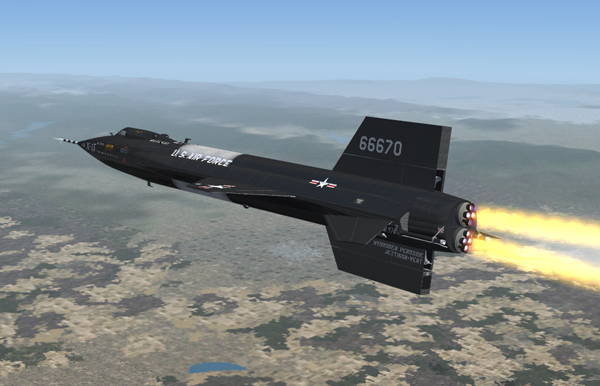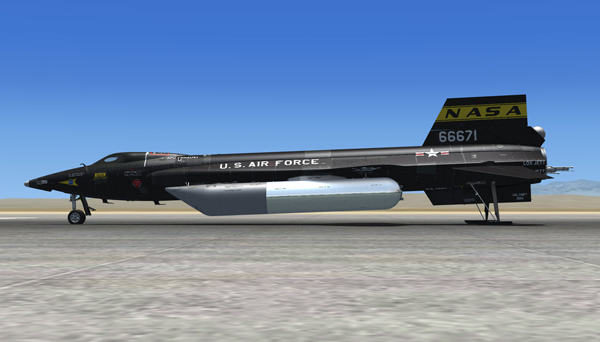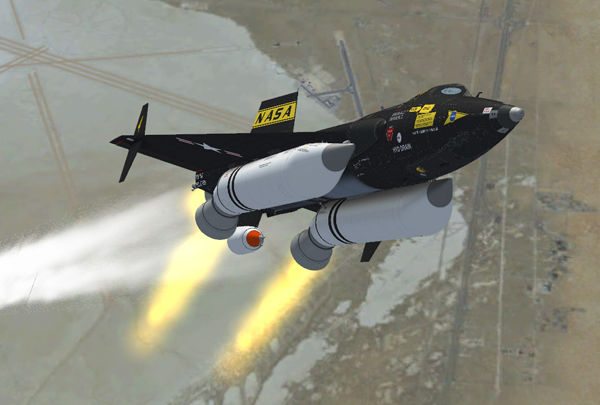
Xtreme Prototypes X-15-1 legacy addon for FS2004 and FSX. Note the interim XLR-11 engines (FS2004 screenshot).
The real X-15 was a single-place research rocket airplane, specifically designed to obtain data on flight at extremely high altitudes and speeds and on the effects of such flight conditions on the aircraft and on the pilot.
Built by North American Aviation in the late 1950s and early 1960s, under public contract by NACA (NASA), the U.S. Air Force and the U.S. Navy, the airplane was developed and tested in two basic configurations:
The 25½ degree swept back wing [2, fig. 3-1] had hydraulically operated flaps on the inboard trailing edge of each wing panel. All aerodynamic control surfaces were actuated by irreversible hydraulic systems.
The horizontal stabilizer had a 15-degree cathedral. The left and right sections moved simultaneously for pitch control, differentially for roll control, and in compound for pitch-roll control.
The upper and lower vertical stabilizers (rudders) were in two sections; a movable outer span for yaw control and a fixed section adjacent to the fuselage. The lower movable section (ventral) was jettisonable for landing. Each fixed section incorporated a split-flap speed brake.
For changes in airplane attitude at altitudes where aerodynamic controls are relatively ineffective, the airplane incorporated a ballistic control system, wherein the release of gas (hydrogen peroxide) through small rockets in the nose and wing caused the airplane to move about each axis as required.
Propellants for the rocket engine(s) and associated turbopump(s) – water-alcohol (XLR-11 engines) or anhydrous ammonia (XLR-99 engine), liquid oxygen and hydrogen peroxide – were carried internally.
Engine pneumatic control systems and propellant tanks were pressurized either by helium or nitrogen gas. The airplane pressurization and air conditioning systems used liquid nitrogen and helium.
Two auxiliary power units (APUs) drove the airplane hydraulic pumps and AC electrical generators. They used hydrogen peroxide as a monopropellant.
The X-15 landing gear consisted of a dual wheel nose gear and two main (rear) landing skids. The gear was lowered in flight by gravity and air loads.
The real X-15 was not designed for normal ground takeoff but was air-launched by a modified B-52 bomber. However, unlike the original airplane, the X-15A-2 SE addon can actually take off from the ground in the simulator, like any other aircraft.

Xtreme Prototypes X-15A-2 SE (clean rollout version).
After the X-15-2 was damaged in 1962, it was rebuilt as a modified "advanced" version of the X-15.
The X-15A-2 Special Edition addon for Flight Simulator X and Prepar3D® is a virtual model of the resulting X-15A-2 rocket plane.
The X-15A-2 was rolled out in early 1964. It was especially designed to attain hypersonic velocities in the range of 8000 feet per second at an altitude of 100,000 feet.
The obvious modifications are the addition of a 29-inch fuselage extension between the internal liquid oxygen and ammonia tanks and two large external propellant tanks which can be jettisoned and reused. The added propellant permits a longer engine run which results in added velocity.
The X-15A-2 external tanks provide an additional 1053 gallons of anhydrous ammonia and 770 gallons of liquid oxygen which corresponds approximately to an additional 60 seconds of engine burn time.
The fuselage extension provides an optical window and additional space for experimental and instrumentation equipment as well as housing for liquid hydrogen. Other changes include a removable right wing tip, a modified (shorter) lower fixed vertical stabilizer for attachment of experimental equipment such as ramjet test bed engines, an extended landing gear, a revised canopy with new elliptical windows, a skylight hatch on top of the instrument compartment, extended side fairings to carry more hydrogen peroxide and a helium spherical tank behind the upper vertical stabilizer.
Hypersonic flight generates tremendous amount of heat and a special ablative coating is used to protect the exterior of the X-15A-2 aircraft during special missions. It consisted of the basic Martin MA-25S pink ablator (that was also used on the space shuttle external tank) sealed with the Dow Corning DC90-090 white protective wear layer.
An “eyelid” was designed to protect the left canopy window from being smeared with ablator residue during high speed flight. The eyelid is closed before the acceleration phase and re-opened before landing.

Xtreme Prototypes X-15AD-4.
The X-15A-2 Special Edition addon package contains three variations of a fictitious delta wing X-15AD-4 aircraft equipped with the XLR-99 rocket engine, rocket engine nozzle extensions, solid rocket boosters, auxiliary vertical stabilizers and a dummy ramjet, based on different proposed configurations for future X-15 airplanes. The rocket boosters would have allowed for a significant increase in altitude (not speed), up to 500,000 feet at a maximum velocity of 8700 feet per second.
In this section:
General Arrangement (X-15AD-4)